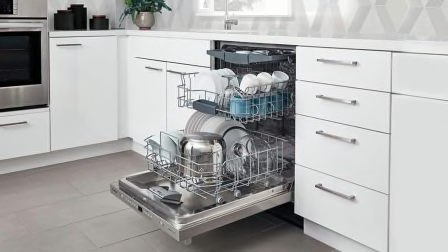If You Want Drier Dishes, Use Dishwasher Rinse Aid
This stuff isn't a gimmick—it really helps
When you shop through retailer links on our site, we may earn affiliate commissions. 100% of the fees we collect are used to support our nonprofit mission. Learn more.

If you want your dishes dry at the end of a cycle, we have three words of advice: Use rinse aid.
Dishwashers dry items in a few different ways. Some use electric heating coils; some use fans. Some automatically pop the door open at the end of a cycle to allow steam to escape—which our testers have noted makes a significant difference in how dry dishes can get.
Some dishwashers raise the temperature of the water at the end of the wash cycle so that the residual heat helps dry dishes. That can be especially effective in dishwashers with stainless steel interiors, which cool down and pull water from the dishes by condensation.
How to Get Drier Dishes
Along with using rinse aid, try these steps to help your dishwasher dry better:
- When loading the dishwasher, place the dishes so they aren’t touching. That improves water circulation.
- Run the kitchen faucet before starting the dishwasher. That way, the water entering the dishwasher is hot from the get-go.
- Use heated dry or other available heating or drying options on your machine.
- As soon as the cycle ends, open the dishwasher door a few inches to let the moist air escape. Then, ideally, leave your dishes to cool down and dry for a little while before you unload.
- When emptying the dishwasher, unload the lower rack first. That way, any water that might have pooled on your cups or mugs in the upper rack won’t spill on the clean dishes below.
The Dishwashers That Dry Best in Our Tests
Not a lot of dishwashers achieve a top score in our drying tests. Here are the ones that do, while also scoring solidly in our other tests.
































